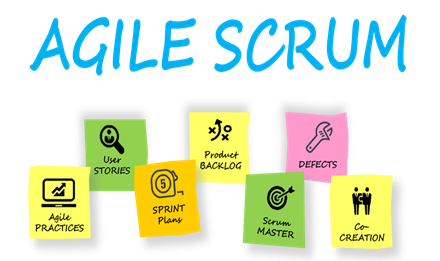SCRUM has quickly become the new standard way to do IT projects. In this article, the authors explain the way SCRUM differs from traditional methods of project management like PRINCE 2 or PMP and why it may help you as a business owner to achieve your goals.
Traditional project management demands detailed upfront planning for a complete project. There is a lot of attention to fixing the scope, in terms of the end product, delivery date, and budget. These parameters must be managed and reported, often in bulky documents to bureaucratic committees. Whereas SCRUM encourages data-based, iterative decision making in which the primary focus is on delivering products that satisfy customer requirements.
To deliver the greatest amount of value in the shortest amount of time, SCRUM promotes prioritization and time-boxing over fixing the scope, cost, and schedule of an entire project. Important features of SCRUM are self-management and cross-functionality, which allow the individuals who are actually doing the work to estimate and take ownership of tasks.
There has always been a lot of “pride” with people who were doing projects in PMP or PRINCE 2, but in reality, there were many problems, in particular in IT projects.
In a lot of projects, the scope seems to be clear in the beginning, but as time goes on, there are either new insights or new external developments that require a change. In such cases, classical project management is too slow and inflexible because it requires time-consuming decision-making. In the end, the project either does not meet the expectations of the end-users or has exceeded its timelines and budgets excessively. Everyone is disappointed.
In classic project management, a lot of roles and responsibilities are clearly defined, and processes are being put in place to help the project advance (monitoring, change management, etc.). This looks solid, but it is not only slowing down the pace of the work (you have to wait for another board meeting before you can continue). It also gives people the entitlement to stick to their own responsibilities only, rather than taking charge of the total project result. One can always refer management to another team member to be blamed for the problems.
SCRUM, on the contrary, acknowledges that most problems are messy, and realities are always changing. It tries to be productive and creative in such a context, AGILE SO TO SPEAK. At the same time, it wants to deliver products of the highest possible value.
In 2000, SCRUM inventors Ken Schwaber and Jeff Sutherland were so frustrated about costly and failing IT projects, that they created the SCRUM guide as an alternative. So, SCRUM is a lightweight framework that helps people, teams, and organizations generate value through adaptive solutions for complex problems. SCRUM as a concept originates in Rugby as the frequent get-together of a team to restart the match after an incident. The SCRUM guide elaborates on that principle with accountabilities, events, artefacts, and the rules that bind them together.
Although SCRUM may be unsuitable for certain projects (like the construction of a power plant where everything needs to be planned upfront) you may want to explore the possible advantages for your business such as faster delivery, higher customer satisfaction, or happy personnel. Learning SCRUM is not difficult: an interactive course of a few days may get you started (various institutes like Maxim Nyansa IT Solutions in Accra, provide in-company training with optional certification exams). But the practice is harder than it seems because SCRUM profoundly changes the way people in the organization interact.
We see that organizations that actually benefit from SCRUM are those who have actively engaged the management as well as the SCRUM teams in the introduction of the concept. Everyone needs to be involved.
For the managers, this is most difficult. They are used to having control of an entire team, but in SCRUM the team gets most of the responsibilities. In the beginning, it may be scary to let go of certain things, but often it turns out to be an advantage that the team members all bring in their talents and ideas and take charge of the result. And of course, any change in the way you work will evoke a certain level of fear and resistance. SCRUM is no exception in that, you must have the courage to embrace change.
However, you will soon find out that your employees will enjoy their work more and be more productive.
If you think this article is appealing to you, you may give it a try starting with a pilot in one of your projects or teams after a short practical training. But if you believe that SCRUM is still a bridge too far for your organization, note that the approach can also be used in your personal life or for your personal development. For example, you can use SCRUM techniques to set your personal goals for your week, your year, or for your personal development. Then, use other SCRUM tools to plan your actions, to monitor, evaluate and continuously improve yourself.
Author: Diana van der Stelt is a social entrepreneur outsourcing SCRUM teams to the Netherlands at Trinity Software Center in Kumasi and the Co-founder of Maxim Nyansa IT solutions, an IT training center in Accra | Member, Institute of ICT Professionals Ghana. Elvin Assiam, agile SCRUM trainer and consultant with Maxim Nyansa IT solutions.
For comments, contact dianavanderstelt@trinitysoftwarecenter.com





